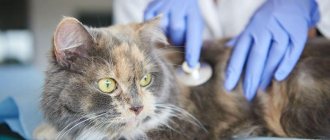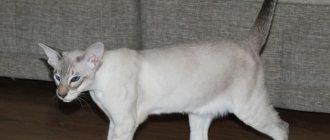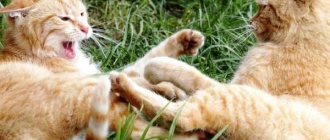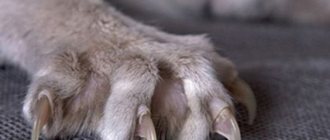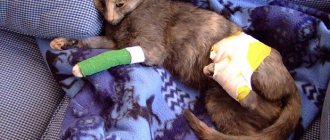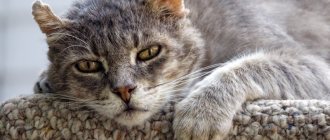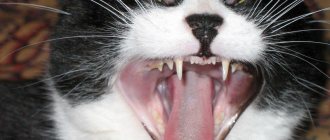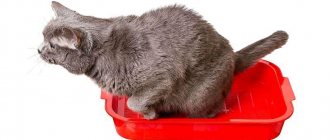Cats are amazing creatures: even if years pass, they have apparently drunk from the fountain of endless youth. However, although they always look young and glowing, cats age just like any other living thing.
Although we don't realize it, cats actually grow faster than other animals. In fact, a cat is already considered an adult when it reaches the age of 7 years. Just like with humans, when a cat reaches this age, its health begins to show signs of change and aging.
It is important for us, as human companions to our pets, to know when this phase begins so that we can take appropriate measures and provide the best lifestyle for your animal. Read this new article and learn 5 signs of old age in cats.
Hearing loss
Hearing loss does not occur in old age in all cats, but it is very common. If you call your cat several times and she doesn't respond, her hearing may not be as good as it used to be.
There are different degrees of deafness, with some cats having only a slight degree. Other older cats may become completely deaf. If you notice any major changes in your cat's feelings or behavior, you will need to contact your veterinarian to rule out another, more serious health problem.
The same thing happens with loss of vision and smell. The breakdown of your pet's senses will lead to attention deficits, and he may begin to become clumsy in his movements and show changes in his mood, so he may be somewhat irritable.
Signs of aging
Behavior change
If at a young and mature age the animal was playful and affectionate, but in old age the character became more irritable, then the cat is aging. Older cats receive less pleasure from their owner's affection and stop accepting them. It happens the other way around: old age makes a pet annoying, he constantly pets. The cat’s character traits change; the previously fearless animal becomes frightened by the usual sounds and movements of the owner, becomes nervous, and is cautious.
Decreased activity
As pets age, they prefer to bask in the sun rather than run.
Decreased mobility also indicates age-related changes. Previously, the cat could run around the house all day, play with various objects, and jump on cabinets. Now she moves and meows less, lies more in the sun, sleeps a lot, and does not lead the usual “hunting” lifestyle at night. She has become indifferent to outdoor games and communication, and it is difficult to cheer her up.
Reduced sensitivity
The sensory organs of animals that age react less strongly to external stimuli. Problems arise with hearing, smell, and functioning of the vestibular apparatus. The owners notice changes that manifest themselves as follows:
- The cat does not respond to its name, does not respond.
- Orients himself in space worse.
- Can’t smell food, the cat needs to poke his nose into the bowl for the pet to start eating.
- The hunting instinct disappears.
Deterioration of coat condition
The older an animal gets, the worse its coat begins to look.
It is believed that diseases of old cats are reflected externally.
Problems first affect the coat. It fades, hairs fall out, and new ones hardly grow, the animal does not lick itself well, which is why tangles form. The procedures necessary in such cases help little, the cats look bad. Often a pet loses weight - this worsens its appearance, and little can be done in this situation.
Changes in eating habits and weight
As your cat gets older, you will find that she eats less or more slowly than before, and her previous appetite will disappear. This happens because over time the digestive system slows down, which can also cause problems with constipation. As digestion becomes slower and more difficult, your cat may also lose weight. If you notice this sign of aging in your cat, it is necessary to adjust the food portions and make changes to her diet.
On the other hand, because older cats are less active, they can gain weight easily and may even become obese. Physical changes are very relative. The situation can get worse if you don't watch out for these symptoms, as it could also be a symptom of diabetes. A common symptom of diabetes in cats is constant eating throughout the day and constant thirst. If you notice this, consult your veterinarian as soon as possible.
How to treat?
Brilliant green solution is used at the first manifestations of pathology.
In the initial stages of the disease, it is necessary to disinfect the area, protect it from bacteria and speed up the regeneration process. The affected areas must be treated with a solution of brilliant green or hydrogen peroxide. A cat that has been lying on one side for a long time (after surgery or injury) needs to be turned over as often as possible and the area with impaired blood supply must be massaged. You can use wiping with camphor alcohol, a solution of potassium permanganate, lubricate with Fitoelita ointment, wound healing ointments such as Bepanten. Bandages are prohibited.
This disease can also be effectively treated with injections of the homeopathic drug “Traumel”. Injections are made 2 times a day and applied to the affected area of the skin. With the help of such a complex, you can achieve a good result, even if the area of the affected tissue is large. Traditional methods for treating bedsores in cats and dogs are lotions made from decoctions of oak bark, sea buckthorn and rose hips. The infrared lamp (blue) actively helps in healing. In the last two stages, surgical care in combination with drug therapy will be required. Bacterial infections can be contagious to people, so it is necessary to disinfect and treat wounds with gloves more often or treat the animal in a hospital.
The animal must be under constant supervision during illness. There is no need to isolate your pet, since the stress that he receives as a result of stiffness of movement alone can aggravate the course and manifestation of the disease. Veterinarians recommend balancing the animal’s diet during the recovery period. Choose hypoallergenic food with plenty of vitamins.
Slowness of movements
Is your cat not as restless and active as before? This may be a sign of old age. As cats age, they become lazy: they prefer to sleep all day rather than chase mice.
It will also be more difficult for them to move around and perform activities that they did before. The cat will continue to play, but with less intensity, and will become bored with moving faster. An older cat will move more forcefully and less smoothly, which may indicate that there is a problem with the joints and muscles, especially in the hips and hind legs. These are all typical signs of old age.
Heart pathologies
The heart, this “fiery engine,” becomes very vulnerable in old age. Dystrophic changes, stress and toxins - all this can lead to unpleasant consequences. You should be wary and show your pet to a veterinarian in the following cases:
- The cat becomes very (too) apathetic and tries not to walk or jump unnecessarily.
- Even after very minor physical exertion, the animal experiences severe shortness of breath , the cat breathes heavily and very hoarsely.
- In advanced cases, swelling is observed, localized in the extremities, abdomen and chest.
Dental problems
Older cats' teeth weaken with age. They may be more sensitive, and if they have a tendency to drool, this may precipitate problems of gingivitis or herpetic gingivostomatitis, in other words general inflammation of the gums.
Just like humans, some cats may even lose teeth, which interferes with the feeding process. To help your cat, you should replace her regular dry food with a more natural one and consider seeing your veterinarian for a thorough oral hygiene routine. You will notice signs that something is wrong with your cat's teeth when you brush them.
Remember that older cats require more care than older cats and require special attention to their diet and health. This article is for informational purposes only and is not intended to prescribe any veterinary treatment or diagnosis. We invite you to take your pet and visit a veterinarian if they are suffering from any distress or pain.
We know that changes inevitably occur in the body of an aging animal. Animals are different species and age differently. In some, for example, in dogs of decorative breeds, age first of all affects the activity of the heart, and in cats the kidneys suffer. We can help our animals adapt to these changes in a variety of ways: supporting them with various medications and nutritional supplements, diagnosing potential diseases in the early stages, and changing their environment. Even communicating with aging four-legged friends needs to be different. Change in nutrient requirements. As dogs age, their metabolism changes and their need for calories decreases. In cats, the energy requirement remains virtually unchanged throughout adult life. Obesity is a major problem for cats in their prime, but older cats tend to lose excess fat. Studies have shown that older cats, like young kittens, do not have the ability to absorb fat.
Changes in skin and hair. Just like humans, cats' coats begin to gray as they age, especially noticeable in black cats. The coat becomes thinner and more lifeless, however, this can be a sign not only of aging, but also of illness or lack of nutrients. Adding fatty acids to the diet helps restore shine to the coat. If changes in fur are very noticeable, then you should take your cat to the vet.
Aging cats may require more careful grooming, with special attention paid to the anal gland area. Grooming is a great way to spend a lot of quality time with your cat. Most likely she really likes your increased attention. It will also help prevent matting, which is a common problem with aging cats. When brushing or petting your cat, pay attention to any swelling, lumps, or open wounds and immediately consult your veterinarian about this.
The skin of an aging animal may also become thinner, less elastic, and more susceptible to injury. Wounds on the skin of older cats usually take longer to heal. One of the problems in older cats can be dry skin, and here again fatty acid supplements will be useful, brushing will help stimulate the sebaceous glands and distribute natural oils throughout the coat.
Brittle claws. Aging cats become more fragile. They should be trimmed more often, as older cats sharpen their claws much less often than young cats.
Decreased mobility. Arthritis is common in aging cats, especially if they suffered joint damage earlier in their lives. Just like in humans, arthritis in cats can take many forms, ranging from mild joint stiffness to severe musculoskeletal problems. It happens that cats have difficulty jumping into their favorite places or going up and down stairs.
Cats are sensitive to many anti-inflammatory drugs, such as aspirin and acetaminophen. Do not give your cat anti-inflammatory or pain medications unless they have been prescribed by your veterinarian. And if you did, then strictly follow the indicated dosage.
Older cats lose muscle mass and muscle tone, and if the muscles are not exercised, they lose strength and elasticity. Cats find it difficult to move and for this reason they move less - a vicious circle begins. Exercise is very important for healthy muscles, heart and digestive system. Curiosity is common even in old cats, so different boxes, bags, slow toys and movies for cats will help to stimulate them. Replace steps with gentle slopes and provide a litter box with low sides for a cat that has difficulty moving. Place the food and litter box in the area of the house where your cat spends the most time.
Dental diseases. Dental disease is one of the body changes that is most commonly seen in aging cats. Research shows that 70% of older cats suffer from gum disease. Regular dental care, including brushing, will help keep these diseases to a minimum. If you don't take good care of your cat's teeth, they can develop serious diseases as they age, which can lead to life-threatening complications. The dental care program includes brushing, regular vet checks, and professional cleaning when necessary.
Weakened intestinal motility (constipation). As cats age, the movement of food through the gastrointestinal tract slows. This can cause constipation, which is common in older cats. Constipation is common in cats that experience pain when defecating, such as those with arthritis or anal gland disease. Being less active and drinking less fluids can also lead to constipation. Hairballs in older cats can cause serious problems if the cat is constipated. Your veterinarian can help you determine whether your cat should be given hairball medication or soak her food to prevent constipation.
Constipation can also be a sign of other serious illnesses and your cat should definitely be seen by a veterinarian.
Weakening of the immune system. As a cat ages, its immune system does not function as effectively, and older cats are prone to infections. And infections at this age are difficult to tolerate, so get your cat vaccinated in a timely manner.
Decreased cardiac activity. As a cat ages, a cat's heart works less efficiently and pumps less blood over a given period of time than when it was young. Cats can develop a heart disease called cardiomyopathy. To diagnose heart disease, methods such as X-ray, ECG, and echocardiogram are used. Depending on the diagnosis, various medications are prescribed.
Reduced lung volume. As an animal ages, the lungs also lose their elasticity. For this reason, the ability to saturate the blood with oxygen decreases. Older cats may be prone to upper respiratory tract infections.
Deterioration of kidney function. Older animals have an increased risk of kidney disease. This may occur due to changes in the kidneys themselves or as a result of dysfunction of other organs, such as the heart, which, if not functioning properly, reduces blood flow to the kidneys. Kidney function can be checked with a blood or urine test. These tests will show whether there is any kidney disease before obvious symptoms appear. The most common sign of kidney disease that owners notice is an increase in water consumption and urination, but this usually occurs when the kidneys are already 70% damaged. If the kidneys are not functioning properly, then to help the body get rid of waste products, you need to use various medications and diet. To prevent dehydration, you need to give more fluids. Before prescribing anesthetics, it is recommended to do a blood test to determine the disease.
Deterioration of liver function. Although the liver has a unique ability to heal itself, it ages just like any other organ in the body. Its ability to purify the blood and produce various enzymes and proteins gradually decreases with age. Sometimes enzyme levels can be elevated in an animal that appears to be healthy. On the other hand, some animals with liver disease have normal levels of enzymes in their blood. So, based on the test results, it is difficult to judge whether the disease actually exists.
Since all medications and anesthetics affect the liver, the dose of these medications should be reduced if the liver is not functioning well. Before anesthesia is administered, a blood test should be performed to determine if the animal has liver problems.
Changes in the activity of glands. During the aging process, some glands produce less hormones, while others, on the contrary, produce more. Hormonal imbalances, especially hyperthyroidism, are common in older cats. Older cats also develop diabetes. A blood test helps diagnose these diseases. Many of them are amenable to medication and other types of treatment.
Changes in the mammary glands. Cats that are not spayed may develop lumps in the mammary glands due to infiltration of fibrous tissue and may develop cancer. Unfortunately, approximately 85% of mammary tumors in cats are malignant. Older cats should have their mammary glands examined regularly.
Changes in behavior. As cats age, they lose their ability to cope with stress and their behavior changes as a result. Aggression, fear of noise, and urinary and fecal incontinence may develop or worsen in older cats. Various medications and behavior modification techniques can help resolve these behavior problems.
Do not adopt a kitten or other animal if you have an old cat, this will be stressful for her. It is best to adopt a kitten while the older animal is still in good shape, is not sick and has normal vision and hearing.
Increased sensitivity to temperature levels. Old cats lose the ability to thermoregulate their body. This means they are less able to adapt to temperature changes. Cats that were able to handle the cold well when they were young are no longer able to do so. Monitor the ambient temperature and make adjustments if necessary to keep your cat comfortable. You may need to move her bed closer to a heat source or purchase a heated bedding if you live in a cold region.
Hearing loss. Some cats experience hearing loss as they age. Minor hearing loss in cats is difficult to detect; very often, hearing disappears almost completely before the owner notices it. The first sign of hearing loss may be aggressive behavior. The cat does not notice the approach of a person, is frightened by the touch and reacts instinctively to this. Hearing loss is usually an irreversible process, but by making some adjustments in your behavior, you can help your pet adjust. You can use light as a signal (when entering a room, quickly turn the light on and off several times). Cats with hearing loss sense vibration, so clapping your hands or stomping on the floor will alert your cat to your presence.
Eye diseases and vision loss. Cats can lose their vision at any age. You will notice that the cat does not follow the toy with its eyes as it moves across the floor, it has difficulty finding its food bowl, and bumps into furniture if it is moved from its usual place. Any changes in vision or appearance of the eye require immediate attention to your veterinarian. An ophthalmological examination should be included in the regular medical examination program.
A variety of changes can occur in the body of aging cats. In some cats they are more pronounced than in others. Age-related changes in some animals can begin at a relatively young age. There are many ways to help your cat adjust to these changes.
You need to examine your aging cat more carefully. Don't chalk up changes in your cat's activity or behavior to "old man quirks." Many of these changes may indicate serious medical conditions. If you have any doubts, consult your veterinarian and discuss any questions you have during your routine examination.
Cognitive dysfunction syndrome - a disease of old cats
Cognitive dysfunction syndrome causes a cat's mental abilities to decline, affecting thinking and memory. The cat learns new knowledge and acquires new skills worse.
About 30% of cats aged 11–14 years and half of cats over 15 years of age suffer from cognitive dysfunction syndrome.
The most obvious symptom of this disease is disorientation. The cat cannot find its way to the door, hides under furniture or in a corner, does not recognize the owner or other pets, runs into doorposts, and does not come when called.
Often the wakefulness and sleep patterns are disrupted (the cat confuses day and night), aimless movements appear, the cat goes to the toilet in the wrong places, and does not strive to communicate with its owners.
Causes of Cognitive Dysfunction Syndrome in Older Cats
- Disturbances of cerebral blood supply.
- Tissue damage from free radicals.
Diagnosis of cognitive dysfunction syndrome in cats
To determine exactly why your cat's behavior has changed, a full examination is necessary. Unfortunately, diagnosis is often complicated by the presence of concomitant diseases that can further aggravate the cat’s condition.
Treatment of cognitive dysfunction syndrome in older cats
Unfortunately, we do not have approved medications for the treatment of cognitive dysfunction syndrome in cats.
Sometimes making changes to your diet helps. An old cat's food should contain essential fatty acids, antioxidants (beta-carotene, vitamins C and E), chondroprotectors, amino acids L-carnitine and lysine.
And, of course, attention and care on your part, peace and creating a cozy and safe environment for an elderly cat will help.
